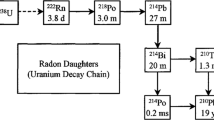Abstract
Hot springs are famous as spa resorts throughout the world. However, these areas usually have high natural radioactivity from radon gas. In this study radon concentrations in air, hot spring water, and bottled mineral water produced in a spa area of Suan Phueng district, Ratchaburi province, Thailand were measured. Radon concentrations in air were in the range of 10–17 and 11–147 Bq/m3 for outdoor and indoor, respectively. Committed effective dose from inhale of radon were assessed and found to be in the range of 0.004–0.025, 0.25–0.6, and 1.134 mSv/y for visitor, local people and resort workers, respectively. These doses were in the range of 1.2 mSv/y regulated by UNSCEAR for the general public. Radon in hot spring water ranged from 2–154 Bq/L. Radon in bottled mineral water produced from the hot spring water were in the range of 17–22 and 0.2–0.3 Bq/L for those that stored for 7 and 90 days, respectively, after production. Radon concentration levels were in the range of the US Environmental Protection Agency reference level for radon in air which is 148 Bq/m3 and alternative maximum concentration limit (AMCL) for raw water which is 150 Bq/L. However, when considering the USEPA (Maximum concentration limit), 11 Bq/L, for radon in drinking water, the mineral water should be stored for at least 8–9 days after bottling before selling to the market.


Similar content being viewed by others
References
Kanghae T, Pinyopornpanich S, Paveenkittipornt W, Tepan J, Sukthana Y, Lekkla A, Mussakarn T, Wanapongse P, Suphachaiyakit T, Bovornkitti S (2004) Intern Med J 20:277–281
Gruber V, Maringer FJ, Landstetter C (2009) J Austria Appl Radiat Isot 67:913–917
Sukthana Y, Wootta W, Paveenkittiporn W, Lekkla A, Dejsirilert S, Kruasilp J, Suthikornchai C, Wanapongse P, Bhandngarm M, Bovornkitti S (2004) Inter Med J Thail 20:211–214
Watanakul P, Paveenkittiporn W, Wootta W, Kruasilp J, Wanapongse P, Sukthana Y, Lekkla A, Suthikornchai C, Bovornkitti S (2004) Inter Med J Thail 20:218–221
Kwanmudeng B, Wiwat L, Sukthana Y, Lekkla A, Wotta W, Paveenkittiporn W, Dejsirilert S, Kruasilp J, Suthikornchai C, Wanapongse P, Bovornkitti S (2004) Inter Med J Thail 20:168–173
Wootta W, Wanapongse P, Paveenkittiporn W, Dejsirilert S, Kruasilp J, Charanasri C, Bovornkitti S (2004) J Health Sci 13:32–36
UNSCEAR (2000) Sources and effects of ionization radiation, report of the United Nation Scientific Committee on the effects of atomic radiation to the General Assembly, with scientific annexes. United Nations, New York
Salih I, Pettersson H, Lund E (2000) J Environ Radioact 48:235–245
Moontep C, Suparom K, Sola B, Chantarachote W, Wanapongese P, Bovornkitti S (2008) Thammasat Med J 8:455–458
Boonyprara S, Wanapongese P, Cheepsattayakorn A, Saeung S, Sola B, Bovornkitti S (2008) J Health Syst Res 2:460–463
US EPA (1992) National emission standards for hazardous air pollutants: emission standards for radon emissions from phosphogypsum stacks (final rule) Federal Register (40CFR61). 57(107): 23305
US EPA (1991) National primary drinking water regulations: radionuclides (Proposed Rule) Federal Register. 56(138): 33050
WHO (2008) Guidelines for drinking water quality, 3rd edn incorporation the first World Health Oranization
Author information
Authors and Affiliations
Corresponding author
Rights and permissions
About this article
Cite this article
Sola, P., Srisuksawad, K., Loaharojanaphand, S. et al. Radon concentration in air, hot spring water, and bottled mineral water in one hot spring area in Thailand. J Radioanal Nucl Chem 297, 183–187 (2013). https://doi.org/10.1007/s10967-012-2359-9
Received:
Published:
Issue Date:
DOI: https://doi.org/10.1007/s10967-012-2359-9




